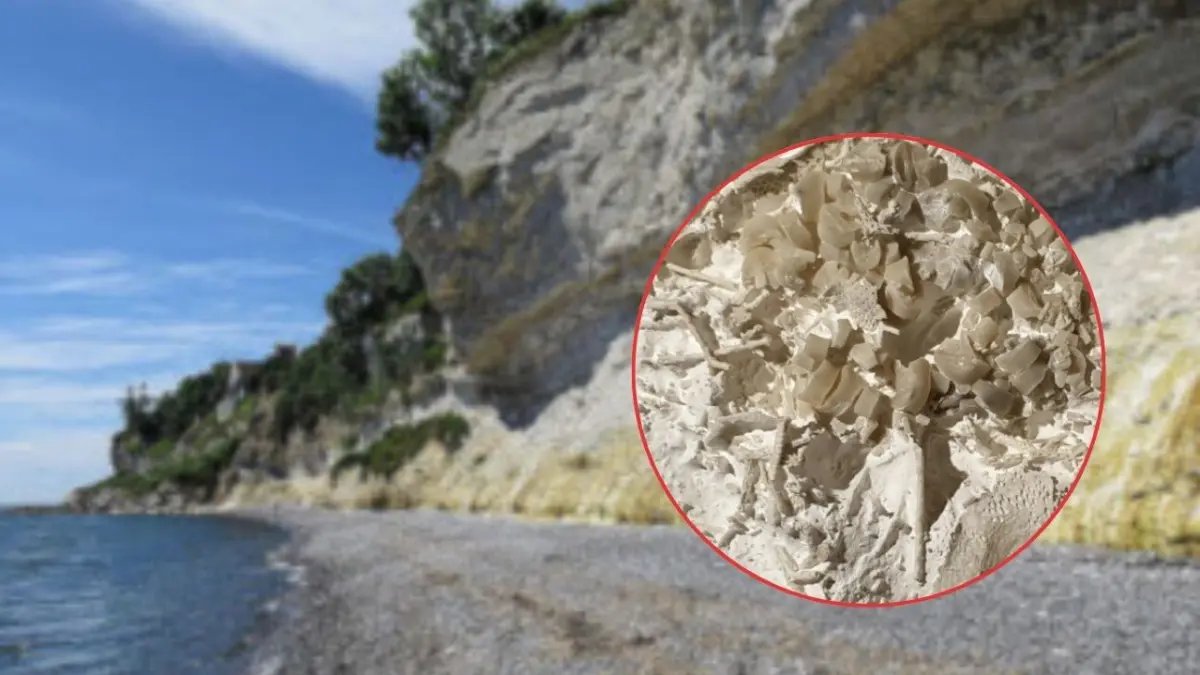
An amazing finding made by a paleontology fan has put scientists to investigate one of the most unusual fossils found in recent years: a phosylized dinosaur vomit
, known as regurgitalito.
This fossil, approximately 66 million, was discovered in the Stevns cliffs, Denmark, and has surprised experts for the unique information it provides about the diet and the interactions between predators and dams in the Cretaceous.
Peter Bennicke, a paleontology fan, made this discovery during an exploration in the Stevns cliffs. While looking for fossil fragments, he noticed some remains with a peculiar texture and shape. When taking them to the Eastern Sjaelland Museum, paleontologists confirmed that it was an extremely rare fossil: A regurgitalite, that is, a fossilized vomit.
(Also read: Why did the world’s watch shortened the time of the arrival of the “Apocalypse”?)
This type of fossil is not only fascinating for its rarity, but because it offers a privileged look at the eating habits of prehistoric animals. The fossil analysis revealed that this was mainly composed of remains of sea lilies, organisms similar to the sea stars that the oceans inhabited at that time.
AFP
A look at the prehistoric diet: what did dinosaurs ate?
The information contained in this fossil is key to understanding the food chains of the past. The analysis has indicated that, although The sea lilies were not a common food source, some prehistoric fish consumed them and then regurgitated them. This type of discovery allows paleontologists to reconstruct the relations between predators and dams, in addition to offering a broader vision of the biodiversity of the Cretaceous.
The regurgitalito also contained remains of bones, teeth and scales of fish and marine reptiles, which suggests that the dinosaur responsible for this prehistoric vomit had a varied diet, which included aquatic dams. In addition, indications of plant materials were found, which implies that some dinosaurs were omnivorous, which adds a new nuance to the understanding of their eating habits.

Dinosaurs Cyl Foundation
The regurgitalites: rare fossils that illuminate the past
This finding has important implications for paleontology, as regurgitalites are extremely rare and valuable. Unlike other fossils, which offer an indirect vision of the diet of extinct animals, these fossils allow to know direct details about what the dinosaurs ate. Thanks to them, scientists can recreate food chains and obtain information about the ecosystems of the past.
Jesper Milàn, paleontologist, stressed the importance of this discovery through the statement: “It is a really unusual finding that sheds light on the relationship between predators and dams in the Cretaceous.”
A key period for the evolution of marine ecosystems
The Cretaceous, a period of evolutionary transformations and great extinctions, was also an era of rich biodiversity. The seas were inhabited by a variety of creatures, including prehistoric fish, ammonites and marine reptiles such as mosasaurs. This dinosaur vomit fossil offers tools to understand how predators interacted with their prey and how food chains developed in the oceans of the past.

Mikkel Houmøller / Wikimedia Commons
Future perspectives: more clues about prehistoric marine ecosystems
This discovery opens the door to new investigations. Scientists expect that, with more studies on vomiting fossil, They can find even more complex details about the marine ecosystems of the Cretaceous. This type of finding helps paleontologists to better understand how dinosaurs adapted to their environment, revealing behaviors and relationships that were previously difficult to identify.
In Milàn’s words, “sea lilies are not a specially nutritious diet, but this discovery reveals that, 66 million years ago, some kind of fish consumed them, which provides a new layer of information on the habits of prehistoric animals. “
(Also read: WhatsApp ai goal recreated image of the Leviathan, a monster mentioned by the Bible)
This dinosaur vomit fossil, one of the most extraordinary found so far, not only enriches scientific knowledge about the fauna of the past, but also deepens understanding about the functioning of ancient ecosystems and complex interactions within them. As more investigations are carried out, new revelations about these creatures are expected to arise.
Source: https://www.noticiascaracol.com/mundo/descubren-un-fosil-de-vomito-de-dinosaurio-de-66-millones-de-anos-en-dinamarca-asi-era-su-dieta-so35


